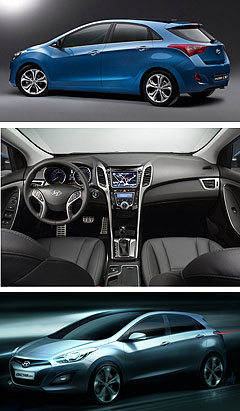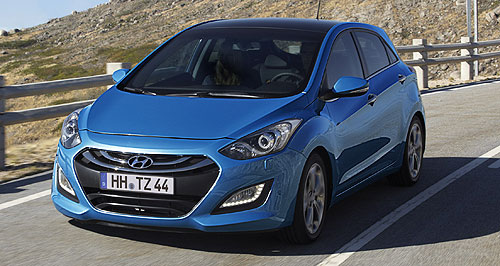Make / Model Search
Future models - Hyundai - i30 - hatchFrankfurt show: Covers torn from next-gen Hyundai i30Small car, big deal: Hyundai's slick new i30 will continue the brand's swooping 'fluidic sculpture' design language. Hyundai’s Mazda3-fighting, second-generation i30 small-car contender revealed7 Sep 2011 HYUNDAI’S crucial second-generation i30 small hatch has broken cover ahead of its public debut at the Frankfurt motor show next week. The redesigned hatchback will replace the South Korean brand’s top-selling model globally and in Australia in the mid-2012, going head-to-head with the recently released third-generation Ford Focus, Holden’s all-new Cruze hatch – designed and built in Australia – and the facelifted Mazda3. The latter two are both due in October this year, while redesigned versions of the Subaru Impreza and Honda Civic will also be gunning for high-volume sales in Australia’s biggest market segment by the time the all-new i30 lands on our shores. A new Toyota Corolla is also expected to launch around the same time. As suggested by the official teaser sketch Hyundai released last month, the first in-the-metal images of the new i30 confirm it will feature much more distinctive and aggressive lines than the current model. This newfound style comes courtesy of liberal use of the brand’s swooping ‘fluidic sculpture’ design language, which can already be seen on models like the i45 medium sedan, Elantra small sedan and ix35 compact SUV. Most notable is the full-body contour that curves in parallel to the muscular front wheelarches before following the sharply curved window line and sloping off under the large tail-lights.  Also evident is the steep, coupe-like roofline extending from the large, sharply raked windscreen and jewelled LED lights inset into the front bumper (at least on the flagship variant shown). Also evident is the steep, coupe-like roofline extending from the large, sharply raked windscreen and jewelled LED lights inset into the front bumper (at least on the flagship variant shown).The sleek headlights and large, hexagonal grille bear strong family resemblance to the Elantra small sedan, which shares the small-car segment with the current i30 hatch and wagon range in our market. The cabin appears more upmarket than the current model, with the same curvaceous themes as most recent Hyundai products, including lashings of chrome-effect and –piano-black plastic inserts. The images show a high-series model that includes features such as satellite-navigation, electric park brake, leather trim, climate control and a host of steering wheel-mounted button controls. Boot space is said to be a commodious 378 litres with rear seats in place, which compares favourably to, for instance, the Volkswagen Golf hatch which has 350 litres. Hyundai has confirmed nothing in the way of powertrain options yet, although UK reports indicate there will be six engines – three petrols and three diesel – offered in that market. On the home front, expect the range to feature a 1.8-litre petrol four-cylinder, as well as a variation of the 1.6-litre Gamma GDi petrol from the Veloster coupe and a 1.6-litre DOHC four-cylinder turbo-diesel which in the forthcoming Accent CRDi will produce 94kW at 4000rpm and 265Nm from 1900 to 2750rpm. New six-speed manual and automatic transmissions are also likely to be available across the range. As GoAuto has reported, a German-designed five-door wagon version of the new i30 should also be forthcoming and is expected to join the hatch in featuring a multi-link rear suspension system. While no dimensions are confirmed, both hatch and wagon are likely to feature bigger and roomier bodies than the existing model, in order to put some distance between it and the new Accent – as well as Hyundai’s next Indian-built i20 light car. Like all other Hyundai models sold here, Australia’s new i30 will continue to be built in Korea, where sales could commence by the end of this year. The original i30 played a significant role in shedding Hyundai’s cheap-and-cheerful image – established by models such as the Excel – into a higher quality contender when it was released here in 2007, largely thanks to its Euro-centric styling, excellent fit and finish and competitive engine line-up (especially the diesel). The current i30 is the fourth-largest seller in Australia’s booming small-car segment so far this year, with a market share of 12.8 per cent placing it behind only the Mazda3, Holden Cruze and Toyota Corolla.  Read moreAll future models Alfa Romeo Alfa Romeo Abarth Abarth Alpine Alpine Alpina Alpina Audi Audi Aston Martin Aston Martin BMW BMW Bentley Bentley Chery Chery Brabham Brabham Chrysler Chrysler Chevrolet Chevrolet Cupra Cupra Citroen Citroen DS DS Dodge Dodge Fiat Fiat Ferrari Ferrari Foton Foton Ford Ford Great Wall Great Wall FPV FPV Haval Haval GWM GWM Honda Honda Holden Holden Hummer Hummer HSV HSV Infiniti Infiniti Hyundai Hyundai Jaguar Jaguar Isuzu Isuzu Kia Kia Jeep Jeep Land Rover Land Rover Lamborghini Lamborghini Lexus Lexus LDV LDV Mahindra Mahindra Lotus Lotus Mazda Mazda Maserati Maserati Mercedes-AMG Mercedes-AMG McLaren McLaren MG MG Mercedes-Benz Mercedes-Benz Mitsubishi Mitsubishi Mini Mini Opel Opel Nissan Nissan Peugeot Peugeot Pagani Pagani Proton Proton Porsche Porsche Renault Renault Ram Ram Rover Rover Rolls-Royce Rolls-Royce Skoda Skoda Saab Saab SsangYong SsangYong Smart Smart Suzuki Suzuki Subaru Subaru Toyota Toyota Tesla Tesla Volvo Volvoi30 pricing
Motor industry news |
Click to shareHyundai modelsAll future models Alfa Romeo Alfa Romeo Abarth Abarth Alpine Alpine Alpina Alpina Audi Audi Aston Martin Aston Martin BMW BMW Bentley Bentley Chery Chery Brabham Brabham Chrysler Chrysler Chevrolet Chevrolet Cupra Cupra Citroen Citroen DS DS Dodge Dodge Fiat Fiat Ferrari Ferrari Foton Foton Ford Ford Great Wall Great Wall FPV FPV Haval Haval GWM GWM Honda Honda Holden Holden Hummer Hummer HSV HSV Infiniti Infiniti Hyundai Hyundai Jaguar Jaguar Isuzu Isuzu Kia Kia Jeep Jeep Land Rover Land Rover Lamborghini Lamborghini Lexus Lexus LDV LDV Mahindra Mahindra Lotus Lotus Mazda Mazda Maserati Maserati Mercedes-AMG Mercedes-AMG McLaren McLaren MG MG Mercedes-Benz Mercedes-Benz Mitsubishi Mitsubishi Mini Mini Opel Opel Nissan Nissan Peugeot Peugeot Pagani Pagani Proton Proton Porsche Porsche Renault Renault Ram Ram Rover Rover Rolls-Royce Rolls-Royce Skoda Skoda Saab Saab SsangYong SsangYong Smart Smart Suzuki Suzuki Subaru Subaru Toyota Toyota Tesla Tesla Volvo Volvoi30 pricing
Motor industry news |










Facebook Twitter Instagram